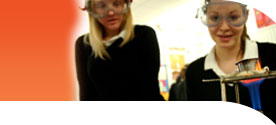



Bradley Stoke Community School opened in September 2005 to serve a rapidly expanding town in north-west Bristol. The school currently has pupils in years 7 and 8 only, and has applied for specialist status in performing arts and languages.
Following the introduction of a healthier lunch menu, the issue of obesity had become topical in the school. The science department wanted to build on the discussions and debates surrounding obesity by integrating the topic into pupils' lessons.
Staff used the topic of obesity to make links with other subject areas and develop pupils' understanding of areas of biology and physics, using a range of practical experiments and activities.
Staff devised a unit of work for science, which put issues of obesity in the context of everyday life. They wanted the project to enable pupils to learn about aspects of science, particularly biology and physics, and extend it into other areas.
At the start of the project, pupils were given a variety of food packaging and asked to order the food according to how much energy they contained. They were then given 'mystery labels' and asked to put them in the correct positions.
Following this, pupils were given the nutritional information contained on a number of food labels, without the product names, and asked to guess the types of food that belonged to the labels.
The teacher used a calorimeter to demonstrate how the energy content of food is calculated. Pupils used the calorimeter to test for the presence of different food types, for example fat, protein and carbohydrate. Pupils were then introduced to the Benedict's test for sugar and given the opportunity to perform the test themselves. They made use of a PDA linked to a calorimeter to get quantitative results.
The second stage of the project looked at the uses of fats in the body, considering why it is needed and where it is stored. The teacher carried out experiments with lard to demonstrate buoyancy, electrical conductivity, energy value (in the food calorimeter), and water proofing (on feathers). The pupils then performed some insulation experiments with various materials, using the PDAs and temperature probes to show how fat as a material is a good insulator.
The pupils moved on to the digestion of fats and stuck the correct parts of the digestive system onto a Velcro body ('Adult Organ Tunic'). A digestive system was mapped out on the floor and the pupils, in small groups, travelled through the digestive system. They discussed what was happening at each stage, splitting up as appropriate. When they were back in the lab, pupils investigated lipase and bile using the PDAs and pH probes.
Pupils then focused on the circulatory system and looked at the movement of the blood in arteries, veins, capillaries in and out of the heart, organs and tissues to the cells. They looked at the content of blood and the parts that carried fats. They then carried out a similar exercise to the one before, tracing the path of blood through the circulatory system of a body mapped out on the floor.
Pupils looked at the impact that fats have on the body. They learned about Body Mass Index (BMI) and its use in defining obesity. Using the internet, pupils researched how obesity affects the developing foetus, whether taking omega-3 oils reduces depression or boosts intelligence and how cows' milk is produced with omega-3 in it.
They then investigated the effects of different masses when dropped into sand, and considered how this investigation could be used to model the effects of obesity on the human body.
'This module was a holistic way of developing ideas around a common theme. The pupils had the opportunity to experience several different ideas, including some from biology and physics, but within one context. As well as becoming aware of the issues, they acknowledged the impact that being obese may have on their own lives.'
Sarah Barker (Head of Science)
'I think that it's a really good idea to learn about one topic. Normally, what we do in different lessons changes. I also really liked it that there were lots of experiments. It's good when we watch demonstrations, but it's even better when we can do them.'
(Lucy)
'I would really like to do activities a lot more during my lessons.'
(Cameron)
'The lessons had loads of practical in them, which I liked best about the science lessons. The PDAs were really fun to use.'
(Abbie)
< Back to New opportunities